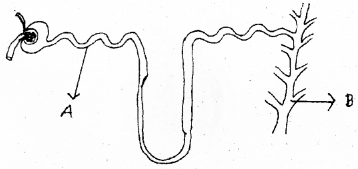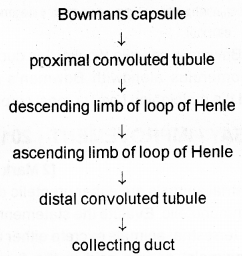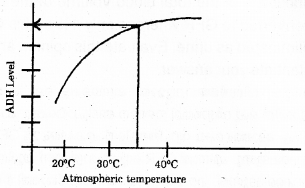Kerala Plus One Zoology Chapter Wise Previous Questions Chapter 8 Excretory Products and their Elimination
Question 1.
Categorize the following animals based on the nature of excretion of nitrogenous waste. (MARCH-2010)
Mammals
Bony fishes
Birds
Aquatic amphibians
Terrestrial amphibians
Insects
Cartilage fishes
Aquatic insects
Answer:
| Ammonotelic | Ureotelic | Uricotelic |
| Bony fishes | Mammals | Birds |
| Aquatic Amphibians | Terrestrial amphibians | Insects |
| Aquatic insects | Cartilage fishes |
Question 2.
In an informal discussion in your class, your friend made a comment that “Malphigean tubules are the kidneys of a cockroach”. How will you evaluate this statement? (MARCH-2010)
Answer:
The statement is correct. The kidney is the excretory organ of man and Malpighian tubules are the excretory organ of cockroach.
Question 3.
Observe the figure. (MARCH-2011)
No need to redraw the figure.

Label A and B and write the function of A and B.
Answer:
A – Proximal convoluted Tubule (PCT)
B – Collecting duct.
Functions:
A- Essential nutrients, 70-80% electrolytes and water are reabsorbed.
B- Reabsorption of water and urea to maintain os- molarity or secretion of H+ and K+ Ions.
Question 4.
a) Prepare a flow chart of filtrate flow in the neph- rone using the following terms. (SAY-2011)
Collecting duct, PCT, DCT, Ascending limb of Henle’s loop, descending limb of Henle’s loop, Bowman’s capsule.
b) Counter current system plays an important role in concentrating urine. Name any two regions inside the kidney, where the counter current system is seen.
Answer:

Descending limb of loop of Henle and ascending limb of loop of Henle.
Question 5.
Complete each of the following sentences using appropriate words. (MARCH-2012)
a) Ascending limb of Henle’s loop is ……….. to water whereas the descending limb is ……… to water.
b) An excessive loss of fluid from the body stimulates the hypothalamus to release ……… hormone from the …………
Answer:
a) Impermeable, Permeable
b) Antidiuretic hormone, Pituitary
Question 6.
Identify the odd one and write the common feature of other items. (SAY-2012)
Nephridia, Malpighian tubule, Spicules, Kidney, Flame cells.
Answer:
Spicules – All other excretory organs.
Question 7.
How does the countercurrent mechanism help to maintain the concentration gradient in the medullary interstitium? (SAY-2012)
Answer:
Mechanism of countercurrent in vasa recta or Henle’s loop makes the difference in osmolarity in glomerular filtrate, blood and interstitium.
Question 8.
On a hot day would you expect your level of ADH in blood to be high or low? Explain. (SAY-2012)
Answer:
ADH increases. It promotes reabsorption of water.
Question 9.
In a Biology class related to excretion in the human body, a student gave an opinion that in every minute about 2% of the total blood volume of the body is converted to GFR whereas only 1% of this GFR is eliminated as urine. Evaluate this opinion and substantiate your answer. (MARCH-2013)
Answer:
In healthy individual the GFR is approximately 125 ml/minute ie, 180 Ltrs. per day. It means that out of 5.5 Ltrs. of blood volume 1.5 Ltrs. per day urine is formed. This is due to re-absorption.
Question 10.
Observe the schematic diagram showing the mechanism for regulating blood volume. (SAY-2013)

Fill the gap in the diagram.
Illustrate how blood volume is regulated by this system.
Answer:
a) Renin
b) A fall in glomemlar blood flow/glomerular blood pressure/GFR can activate the JG cells to release renin which converts angiotensinogen in blood to angiotensin I and further to angiotensin II. Angiotensin II increases the glomerular blood pressure and thereby GFR.
Question 11.
The output of urine increases in cold days while de-creases in hot and sunny days. Can you give a rea-son for this phenomenon as realized from the graph given below? (MARCH-2014)

Answer:
Cold day – The release of low quantity of ADH de-creases tubular re-absorption of water and increases urine output.
Hot day – The release of high quantity of ADH increases tubular re-absorption of water and decreases urine output.
Question 12.
A diagrammatic representation of a nephron is given. (SAY-2014)
a) Identify the parts labelled as X and Y.
b) Which part/parts of a nephron constitute the malpighian body?

Answer:
a) X-Bowmans capsule Y-collecting duct
b) Glomerulus along with Bowman’s capsule is called the malpighian body or renal corpuscle
Question 13.
Terrestrial animals are either ureotelic or uricotelic not ammonotelic. Evaluate the statement. (SAY-2015)
Answer:
Many terrestrial animals excrete either urea (ureotelic animals) or uric acid in the form of a pellet (urecotelic animals)
Question 14.
“The functioning of human kidney is efficiently monitored and regulated by hormonal actions of hypo-thalamus pituitory, JGA and to a certain extent by heart.” (MARCH-2016)
a) Do you agree with ,th is statement?
b) Justify your answerwith suitable reasons.
Answer:
a) yes
b) ADH It affect the kidney function by constricting effects on blood vessels – helps in water reabsorption
JGA is found in the distal convoluted tubule.A fall in GFR can activate the JG cells to release renin which can stimulate the glomerular blood flow.
ANF – It can cause vasodilation (dilation of blood vessels) and thereby decrease the blood pressure.
Question 15.
Uricotelism is more advantageous than ureotelism and ammonotelism in strictly terrestrial animals on the basis of water conservation in the body. Justify. (SAY-2016)
Answer:
Uric acid is the least toxic
It is the terrestrial adaptation and minimum water loss occurs
Question 16.
Prepare two matching pairs from the given list of animals and excretory organs. (MARCH-2017)
| Animals | Excretory organs |
| a) Prawn b) Cockroach c) Earthworm | i) Nephridia ii) Antennal gland iii) Flame cells iv) Kidneys |
Answer:
Prawn – antennal gland
Earthworm – nephridia
